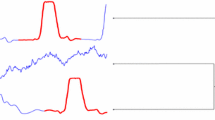Abstract
Time series data can be found in almost every domain, ranging from the medical field to manufacturing and wireless communication. Generating realistic and useful exemplars and prototypes is a fundamental data analysis task. In this paper, we investigate a novel approach to generating realistic and useful exemplars and prototypes for time series data. Our approach uses a new form of time series average, the ShapeDTW Barycentric Average. We therefore turn our attention to accurately generating time series prototypes with a novel approach. The existing time series prototyping approaches rely on the Dynamic Time Warping (DTW) similarity measure such as DTW Barycentering Average (DBA) and SoftDBA. These last approaches suffer from a common problem of generating out-of-distribution artifacts in their prototypes. This is mostly caused by the DTW variant used and its incapability of detecting neighborhood similarities, instead it detects absolute similarities. Our proposed method, ShapeDBA, uses the ShapeDTW variant of DTW, that overcomes this issue. We chose time series clustering, a popular form of time series analysis to evaluate the outcome of ShapeDBA compared to the other prototyping approaches. Coupled with the k-means clustering algorithm, and evaluated on a total of 123 datasets from the UCR archive, our proposed averaging approach is able to achieve new state-of-the-art results in terms of Adjusted Rand Index.
Access this chapter
Tax calculation will be finalised at checkout
Purchases are for personal use only
Similar content being viewed by others
References
Aghabozorgi, S., Shirkhorshidi, A.S., Wah, T.Y.: Time-series clustering-a decade review. Inf. Syst. 53, 16–38 (2015)
Benavoli, A., Corani, G., Mangili, F.: Should we really use post-hoc tests based on mean-ranks? J. Mach. Learn. Res. 17(1), 152–161 (2016)
Cuturi, M., Blondel, M.: Soft-DTW: a differentiable loss function for time-series. In: International Conference on Machine Learning, pp. 894–903. PMLR (2017)
Dau, H.A., et al.: The UCR time series archive. IEEE/CAA J. Automatica Sinica 6(6), 1293–1305 (2019)
Forestier, G., Petitjean, F., Webb, G., Dau, H.A., Keogh, E.: Generating synthetic time series to augment sparse datasets. In: IEEE International Conference on Data Mining (ICDM), pp. 865–870 (2017). https://doi.org/10.1109/ICDM.2017.106
Gee, A.H., Garcia-Olano, D., Ghosh, J., Paydarfar, D.: Explaining deep classification of time-series data with learned prototypes. In: CEUR Workshop Proceedings, vol. 2429, p. 15. NIH Public Access (2019)
Holder, C., Middlehurst, M., Bagnall, A.: A review and evaluation of elastic distance functions for time series clustering. arXiv preprint arXiv:2205.15181 (2022)
Holm, S.: A simple sequentially rejective multiple test procedure. Scand. J. Stat. 6, 65–70 (1979)
Hubert, L., Arabie, P.: Comparing partitions. J. Classif. 2, 193–218 (1985)
Ismail-Fawaz, A., et al.: An approach to multiple comparison benchmark evaluations that is stable under manipulation of the comparate set. arXiv preprint arXiv:2305.11921 (2023)
Ismail Fawaz, H., Forestier, G., Weber, J., Idoumghar, L., Muller, P.A.: Data augmentation using synthetic data for time series classification with deep residual networks. In: ECML/PKDD Workshop on Advanced Analytics and Learning on Temporal Data (2018)
Lafabregue, B., Weber, J., Gançarski, P., Forestier, G.: End-to-end deep representation learning for time series clustering: a comparative study. Data Min. Knowl. Disc. 36(1), 29–81 (2022)
Liao, T.W.: Clustering of time series data-a survey. Pattern Recogn. 38(11), 1857–1874 (2005)
Müller, M.: Dynamic time warping. In: Information Retrieval for Music and Motion, pp. 69–84 (2007)
Paparrizos, J., Gravano, L.: k-Shape: efficient and accurate clustering of time series. In: Proceedings of the 2015 ACM SIGMOD International Conference on Management of Data, pp. 1855–1870 (2015)
Petitjean, F., Forestier, G., Webb, G., Nicholson, A., Chen, Y., Keogh, E.: Dynamic time warping averaging of time series allows faster and more accurate classification. In: IEEE International Conference on Data Mining (ICDM), pp. 470–479 (2014). https://doi.org/10.1109/ICDM.2014.27
Petitjean, F., Ketterlin, A., Gançarski, P.: A global averaging method for dynamic time warping, with applications to clustering. Pattern Recogn. 44(3), 678–693 (2011)
Tan, C.W., Petitjean, F., Keogh, E., Webb, G.I.: Time series classification for varying length series. arXiv preprint arXiv:1910.04341 (2019)
Wilcoxon, F.: Individual comparisons by ranking methods. In: Kotz, S., Johnson, N.L. (eds.) Breakthroughs in Statistics. Springer Series in Statistics: Methodology and Distribution, pp. 196–202. Springer, New York (1992). https://doi.org/10.1007/978-1-4612-4380-9_16
Zhao, J., Itti, L.: ShapeDTW: shape dynamic time warping. Pattern Recogn. 74, 171–184 (2018)
Acknowledgements
This work was supported by the ANR DELEGATION project (grant ANR-21-CE23-0014) of the French Agence Nationale de la Recherche. The authors would like to acknowledge the High Performance Computing Center of the University of Strasbourg for supporting this work by providing scientific sup- port and access to computing resources. Part of the computing resources were funded by the Equipex Equip@Meso project (Programme Investissements d’Avenir) and the CPER Alsacalcul/Big Data. The authors would also like to thank the creators and providers of the UCR Archive.
Author information
Authors and Affiliations
Corresponding author
Editor information
Editors and Affiliations
Rights and permissions
Copyright information
© 2023 The Author(s), under exclusive license to Springer Nature Switzerland AG
About this paper
Cite this paper
Ismail-Fawaz, A. et al. (2023). ShapeDBA: Generating Effective Time Series Prototypes Using ShapeDTW Barycenter Averaging. In: Ifrim, G., et al. Advanced Analytics and Learning on Temporal Data. AALTD 2023. Lecture Notes in Computer Science(), vol 14343. Springer, Cham. https://doi.org/10.1007/978-3-031-49896-1_9
Download citation
DOI: https://doi.org/10.1007/978-3-031-49896-1_9
Published:
Publisher Name: Springer, Cham
Print ISBN: 978-3-031-49895-4
Online ISBN: 978-3-031-49896-1
eBook Packages: Computer ScienceComputer Science (R0)





